A Practical Multi-Sensor Cooling Demand Estimation Approach Based on Visual, Indoor and Outdoor Information Sensing
Abstract
1. Introduction
1.1. Background
1.2. Related Work
1.2.1. Occupancy Detection Technologies
1.2.2. Occupancy Detection Using Cameras and Other Sensors for HVAC Applications
1.2.3. Algorithms for Vision-Based Occupancy Detection
1.3. Summary
2. Methodology
2.1. Overview
- Room environmental conditions may include room temperature, relative humidity and CO2 concentration, which are gathered by the BMS.
- Weather conditions may include outdoor temperature, relative humidity and solar radiation (if there are external walls or windows), which can be obtained from an online weather system.
- Occupancy density is estimated by the number of foreground moving pixels based on the background-subtracted images.
- (1)
- should cover the whole, or most, of the occupied space;
- (2)
- does not pan and tilt;
- (3)
- does not have fisheye lens;
- (4)
- does not have any automatic control, such as, zooming, exposure and white balance.
- (5)
- the resolution of the used cameras is close to the building surveillance camera with a usual resolution of about 320 × 240 pixels (thus, the proposed approach can also make use of existing surveillance camera systems if the privacy issue is properly solved).
2.2. Occupancy Density Estimation Based on Foreground Moving Pixels
2.3. Adaptive GMM
- (1)
- Classify the new sample with:
- (2)
- Update:
- (3)
- Update:
2.4. ANN Modelling
3. Experiment Setup
3.1. Test Room and Cooling System
3.2. Sensing System and ANN Algorithm
3.3. Test Days and Weather Data
4. Results
4.1. Relationships between DFMP and Activity Type
4.2. Cooling Demand Estimation
- is the return air temperature (°C)
- is the supply air temperature (°C)
- is the air density (kg/m3)
- is the air volume flow rate (m3/s)
- is the specific heat capacity of air [J/(kg·°C)]
- is the sensible space cooling load (W)
- is the time index
5. Discussions
5.1. Cooling Demand Estimation Performance and Implications
5.2. Cost and Computation
5.3. Potential Applications
5.4. Limitations
6. Conclusions
Author Contributions
Funding
Conflicts of Interest
Nomenclature
| AHU | Air handling unit |
| ANN | Artificial neural network |
| BLE | Bluetooth Low Energy |
| BMS | Building management system |
| CAV | constant air volume |
| DFMP | Density of foreground moving pixels |
| GMM | Gaussian mixture model |
| HVAC | Heating, ventilation and air conditioning |
| MCU | micro controller unit |
| PI | proportional-integral |
| PIR | Passive infrared |
| R | correlation coefficient |
| RFID | Radio-frequency identification |
| RMSE | root mean squared error |
References
- Electrical and Mechanical Services Department (EMSD). Hong Kong Energy End-Use Data 2017. 2017. Available online: https://www.emsd.gov.hk/filemanager/en/content_762/HKEEUD2017.pdf (accessed on 8 October 2018).
- U.S. Department of Energy. Building Energy Data Book; D&R International, Ltd.: Silver Spring, MD, USA, 2012.
- Wang, J.; Huang, G.; Sun, Y.; Liu, X. Event-Driven Optimization of Complex HVAC Systems. Energy Build. 2016, 133, 79–87. [Google Scholar] [CrossRef]
- Royapoor, M.; Antony, A.; Roskilly, T. A Review of Building Climate and Plant Controls and a Survey of Industry Perspectives. Energy Build. 2017, 158, 453–465. [Google Scholar] [CrossRef]
- Peng, Y.; Rysanek, A.; Nagy, Z.; Schlüter, A. Occupancy Learning-Based Demand-Driven Cooling Control for Office Spaces. Build. Environ. 2017, 122, 145–160. [Google Scholar] [CrossRef]
- Siano, P. Demand Response and Smart grids—A Survey. Renew. Sustain. Energy Rev. 2014, 30, 461–478. [Google Scholar] [CrossRef]
- Sun, Z.; Wang, S.; Ma, Z. In-Situ Implementation and Validation of a CO2-Based Adaptive Demand-Controlled Ventilation Strategy in a Multi-Zone Office Building. Build. Environ. 2011, 46, 124–133. [Google Scholar] [CrossRef]
- Leung, M.C.; Tse, N.C.F.; Lai, L.L.; Chow, T.T. The Use of Occupancy Space Electrical Power Demand in Building Cooling Load Prediction. Energy Build. 2012, 55, 151–163. [Google Scholar] [CrossRef]
- Kwok, S.S.K.; Lee, E.W.M. A Study of the Importance of Occupancy to Building Cooling Load in Prediction by Intelligent Approach. Energy Convers. Manag. 2011, 52, 2555–2564. [Google Scholar] [CrossRef]
- Bourobou, S.T.M.; Yoo, Y. User Activity Recognition in Smart Homes using Pattern Clustering Applied to Temporal ANN Algorithm. Sensors 2015, 15, 11953–11971. [Google Scholar] [CrossRef] [PubMed]
- Ding, Y.; Wang, Z.; Feng, W.; Marnay, C.; Zhou, N. Influence of Occupancy-Oriented Interior Cooling Load on Building Cooling Load Design. Appl. Therm. Eng. 2016, 96, 411–420. [Google Scholar] [CrossRef]
- Yang, Z.; Becerik-Gerber, B. Assessing the Impacts of Real-Time Occupancy State Transitions on Building Heating/Cooling Loads. Energy Build. 2017, 135, 201–211. [Google Scholar] [CrossRef]
- Nguyen, T.A.; Aiello, M. Energy Intelligent Buildings Based on User Activity: A Survey. Energy Build. 2013, 56, 244–257. [Google Scholar] [CrossRef]
- Dong, B.; Andrews, B. Sensor-Based Occupancy Behavioral Pattern Recognition for Energy and Comfort Management in Intelligent Buildings. In Proceedings of the Eleventh International IBPSA Conference, Glasgow, UK, 27–30 July 2009; pp. 1444–1451. [Google Scholar]
- Weekly, K.; Jin, M.; Zou, H.; Hsu, C.; Soyza, C.; Bayen, A.; Bayen, C. Building-in-Briefcase: A Rapidly-Deployable Environmental Sensor Suite for the Smart Building. Sensors 2018, 18, 1381. [Google Scholar] [CrossRef] [PubMed]
- Zou, H.; Zhou, Y.; Jiang, H.; Chien, S.; Xie, L.; Spanos, C.J. WinLight: A WiFi-Based Occupancy-Driven Lighting Control System for Smart Building. Energy Build. 2018, 158, 924–938. [Google Scholar] [CrossRef]
- Melfi, R.; Rosenblum, B.; Nordman, B.; Christensen, K. Measuring Building Occupancy using Existing Network Infrastructure. In Proceedings of the 2011 International Green Computing Conference and Workshops, Orlando, FL, USA, 25–28 July 2011; pp. 1–8. [Google Scholar]
- Yan, D.; O’Brien, W.; Hong, T.; Feng, X.; Burak Gunay, H.; Tahmasebi, F.; Mahdavi, A. Occupant Behavior Modeling for Building Performance Simulation: Current State and Future Challenges. Energy Build. 2015, 107, 264–278. [Google Scholar] [CrossRef]
- Wang, W.; Chen, J.; Lu, Y.; Wei, H. Energy Conservation through Flexible HVAC Management in Large Spaces: An IPS-Based Demand-Driven Control (IDC) System. Autom. Constr. 2017, 83, 91–107. [Google Scholar] [CrossRef]
- Marinakis, V.; Doukas, H. An Advanced IoT-Based System for Intelligent Energy Management in Buildings. Sensors 2018, 18, 610. [Google Scholar] [CrossRef] [PubMed]
- Amaxilatis, D.; Akrivopoulos, O.; Mylonas, G.; Chatzigiannakis, I. An IoT-Based Solution for Monitoring a Fleet of Educational Buildings Focusing on Energy Efficiency. Sensors 2017, 17, 2296. [Google Scholar] [CrossRef] [PubMed]
- Zou, H.; Jiang, H.; Yang, J.; Xie, L.; Spanos, C. Non-Intrusive Occupancy Sensing in Commercial Buildings. Energy Build. 2017, 154, 633–643. [Google Scholar] [CrossRef]
- Dong, B.; Andrews, B.; Lam, K.P.; Höynck, M.; Zhang, R.; Chiou, Y.; Benitez, D. An Information Technology Enabled Sustainability Test-Bed (ITEST) for Occupancy Detection through an Environmental Sensing Network. Energy Build. 2010, 42, 1038–1046. [Google Scholar] [CrossRef]
- Cheng, C.; Lee, D. Enabling Smart Air Conditioning by Sensor Development: A Review. Sensors 2016, 16, 2028. [Google Scholar] [CrossRef] [PubMed]
- Zhu, Q.; Chen, Z.; Masood, M.K.; Soh, Y.C. Occupancy Estimation with Environmental Sensing via Non-Iterative LRF Feature Learning in Time and Frequency Domains. Energy Build. 2017, 141, 125–133. [Google Scholar] [CrossRef]
- Candanedo, L.M.; Feldheim, V. Accurate Occupancy Detection of an Office Room from Light, Temperature, Humidity and CO2 Measurements using Statistical Learning Models. Energy Build. 2016, 112, 28–39. [Google Scholar] [CrossRef]
- Javed, A.; Larijani, H.; Ahmadinia, A.; Emmanuel, R.; Mannion, M.; Gibson, D. Design and Implementation of a Cloud Enabled Random Neural Network-Based Decentralized Smart Controller with Intelligent Sensor Nodes for HVAC. IEEE Internet Things J. 2017, 4, 393–403. [Google Scholar] [CrossRef]
- Javed, A.; Larijani, H.; Ahmadinia, A.; Emmanuel, R.; Gibson, D.; Clark, C. Experimental Testing of a Random Neural Network Smart Controller Using a Single Zone Test Chamber. IET Netw. 2015, 4, 350–358. [Google Scholar] [CrossRef]
- Meyn, S.; Surana, A.; Lin, Y.; Oggianu, S.M.; Narayanan, S.; Frewen, T.A. A Sensor-Utility-Network Method for Estimation of Occupancy in Buildings. In Proceedings of the 48h IEEE Conference on Decision and Control (CDC) held jointly with 2009 28th Chinese Control Conference, Shanghai, China, 15–18 December 2009; pp. 1494–1500. [Google Scholar]
- Aftab, M.; Chen, C.; Chau, C.; Rahwan, T. Automatic HVAC Control with Real-Time Occupancy Recognition and Simulation-Guided Model Predictive Control in Low-Cost Embedded System. Energy Build. 2017, 154, 141–156. [Google Scholar] [CrossRef]
- Wang, F.; Feng, Q.; Chen, Z.; Zhao, Q.; Cheng, Z.; Zou, J.; Zhang, Y.; Mai, J.; Li, Y.; Reeve, H. Predictive Control of Indoor Environment using Occupant Number Detected by Video Data and CO2 Concentration. Energy Build. 2017, 145, 155–162. [Google Scholar] [CrossRef]
- Kjærgaard, M.B.; Sangogboye, F.C. Categorization Framework and Survey of Occupancy Sensing Systems. Pervasive Mob. Comput. 2017, 38, 1–13. [Google Scholar] [CrossRef]
- Diraco, G.; Leone, A.; Siciliano, P. People Occupancy Detection and Profiling with 3D Depth Sensors for Building Energy Management. Energy Build. 2015, 92, 246–266. [Google Scholar] [CrossRef]
- Zou, J.; Zhao, Q.; Yang, W.; Wang, F. Occupancy Detection in the Office by Analyzing Surveillance Videos and its Application to Building Energy Conservation. Energy Build. 2017, 152, 385–398. [Google Scholar] [CrossRef]
- Moeslund, T.B.; Hilton, A.; Krüger, V.; Sigal, L. Visual Analysis of Humans; Springer: London, UK, 2011. [Google Scholar]
- Sobral, A.; Vacavant, A. A Comprehensive Review of Background Subtraction Algorithms Evaluated with Synthetic and Real Videos. Comput. Vis. Image Underst. 2014, 122, 4–21. [Google Scholar] [CrossRef]
- Stauffer, C.; Grimson, W.E.L. Adaptive Background Mixture Models for Real-Time Tracking. In Proceedings of the IEEE Computer Society Conference on Computer Vision and Pattern Recognition, Fort Collins, CO, USA, 23–25 June 1999; pp. 246–252. [Google Scholar]
- KaewTraKulPong, P.; Bowden, R. An Improved Adaptive Background Mixture Model for Real-Time Tracking with Shadow Detection. In Video-Based Surveillance Systems; Springer: Boston, MA, USA, 2002; Volume 1, pp. 135–144. [Google Scholar]
- Chen, Y.; Chen, C.; Huang, C.; Hung, Y. Efficient Hierarchical Method for Background Subtraction. Pattern Recognit. 2007, 40, 2706–2715. [Google Scholar] [CrossRef]
- Zivkovic, Z.; Van Der Heijden, F. Efficient Adaptive Density Estimation Per Image Pixel for the Task of Background Subtraction. Pattern Recognit. Lett. 2006, 27, 773–780. [Google Scholar] [CrossRef]
- Zivkovic, Z. Improved Adaptive Gaussian Mixture Model for Background Subtraction. In Proceedings of the 17th International Conference on Pattern Recognition (ICPR 2004), Cambridge, UK, 26 August 2004; pp. 28–31. [Google Scholar]
- Mestre, G.; Ruano, A.; Duarte, H.; Silva, S.; Khosravani, H.; Pesteh, S.; Ferreira, P.M.; Horta, R. An Intelligent Weather Station. Sensors 2015, 15, 31005–31022. [Google Scholar] [CrossRef] [PubMed]
- Melo, A.P.; Versage, R.S.; Sawaya, G.; Lamberts, R. A Novel Surrogate Model to Support Building Energy Labelling System: A New Approach to Assess Cooling Energy Demand in Commercial Buildings. Energy Build. 2016, 131, 233–247. [Google Scholar] [CrossRef]
- Yang, Z.; Li, N.; Becerik-Gerber, B.; Orosz, M. A Systematic Approach to Occupancy Modeling in Ambient Sensor-Rich Buildings. Simulation 2014, 90, 960–977. [Google Scholar] [CrossRef]
- Ma, R.; Li, L.; Huang, W.; Tian, Q. On Pixel Count Based Crowd Density Estimation for Visual Surveillance. In Proceedings of the 2004 IEEE Conference on Cybernetics and Intelligent Systems, Singapore, 1–3 December 2004; pp. 170–173. [Google Scholar]
- American Society of Heating Refrigerating and Air-Conditioning Engineers (ASHRAE). ASHRAE Handbook—Fundamental (SI); ASHRAE: Atlanta, GA, USA, 2009. [Google Scholar]
- Sample Video of Grand Central Station. Available online: ftp://ivp-db.ee.cuhk.edu.hk/xgwang/grandcentral_data/grandcentral.avi (accessed on 8 October 2018).
- An, R.; Li, W.J.; Han, H.G.; Qiao, J.F. An Improved Levenberg-Marquardt Algorithm with Adaptive Learning Rate for RBF Neural Network. In Proceedings of the 2016 35th Chinese Control Conference (CCC), Chengdu, China, 27–29 July 2016; pp. 3630–3635. [Google Scholar]
- World-Weather-Online. Weather in Kowloon Tong, Hong Kong. 2017. Available online: https://www.worldweatheronline.com/ (accessed on 8 October 2018).
- Raspberry Pi Foundation. Raspberry Pi. Available online: https://www.raspberrypi.org/ (accessed on 8 October 2018).
- Ahmad, M.W.; Mourshed, M.; Rezgui, Y. Trees Vs Neurons: Comparison between Random Forest and ANN for High-Resolution Prediction of Building Energy Consumption. Energy Build. 2017, 147, 77–89. [Google Scholar] [CrossRef]
- Zhang, S.; Cheng, Y.; Fang, Z.; Huan, C.; Lin, Z. Optimization of Room Air Temperature in Stratum-Ventilated Rooms for both Thermal Comfort and Energy Saving. Appl. Energy 2017, 204, 420–431. [Google Scholar] [CrossRef]
- Saleh, S.A.M.; Suandi, S.A.; Ibrahim, H. Recent Survey on Crowd Density Estimation and Counting for Visual Surveillance. Eng. Appl. Artif. Intell. 2015, 41, 103–114. [Google Scholar] [CrossRef]
- Ren, S.; He, K.; Girshick, R.; Sun, J. Faster R-CNN: Towards Real-Time Object Detection with Region Proposal Networks. In Proceedings of the Advances in Neural Information Processing Systems (NIPS 2015), Montreal, QC, Canada, 7–12 December 2015; pp. 91–99. [Google Scholar]
- Redmon, J.; Divvala, S.; Girshick, R.; Farhadi, A. You Only Look Once: Unified, Real-Time Object Detection. In Proceedings of the IEEE Conference on Computer Vision and Pattern Recognition, Las Vegas, NV, USA, 27–30 June 2016; pp. 779–788. [Google Scholar]
- YOLO: Real-Time Object Detection. Available online: https://pjreddie.com/darknet/yolo/?utm_source=next.36kr.com (accessed on 25 August 2018).
- Huang, W.Z.; Zaheeruddin, M.; Cho, S.H. Dynamic Simulation of Energy Management Control Functions for HVAC Systems in Buildings. Energy Convers. Manag. 2006, 47, 926–943. [Google Scholar] [CrossRef]
- Zhou, P.; Huang, G.; Li, Z. Demand-Based Temperature Control of Large-Scale Rooms Aided by Wireless Sensor Network: Energy Saving Potential Analysis. Energy Build. 2014, 68, 532–540. [Google Scholar] [CrossRef]
- Wang, W.; Wang, J.; Chen, J.; Huang, G. Multi-Zone Outdoor Air Coordination through Wi-Fi Probe-Based Occupancy Sensing. Energy Build. 2018, 159, 495–507. [Google Scholar] [CrossRef]
- Zhou, P.; Wang, J.; Huang, G. A Coordinated VAV Control with Integration of Heat Transfer Coefficients for Improving Energy Efficiency and Thermal Comfort. Energy Procedia 2017, 143, 271–276. [Google Scholar] [CrossRef]
- Wang, J.; Jia, Q.; Huang, G.; Sun, Y. Event-Driven Optimal Control of Central Air-Conditioning Systems: Event-Space Establishment. Sci. Technol. Built Environ. 2018, 1–34. [Google Scholar] [CrossRef]
- Martínez-Rodríguez, M.C.; Prada-Delgado, M.A.; Brox, P.; Baturone, I. VLSI Design of Trusted Virtual Sensors. Sensors 2018, 18, 347. [Google Scholar] [CrossRef] [PubMed]
- Shen, W.; Newsham, G.; Gunay, B. Leveraging Existing Occupancy-Related Data for Optimal Control of Commercial Office Buildings: A Review. Adv. Eng. Inform. 2017, 33, 230–242. [Google Scholar] [CrossRef]
- Zhang, S.; Cheng, Y.; Fang, Z.; Lin, Z. Dynamic control of room air temperature for stratum ventilation based on heat removal efficiency: Method and experimental validations. Build. Environ. 2018, 140, 107–118. [Google Scholar] [CrossRef]
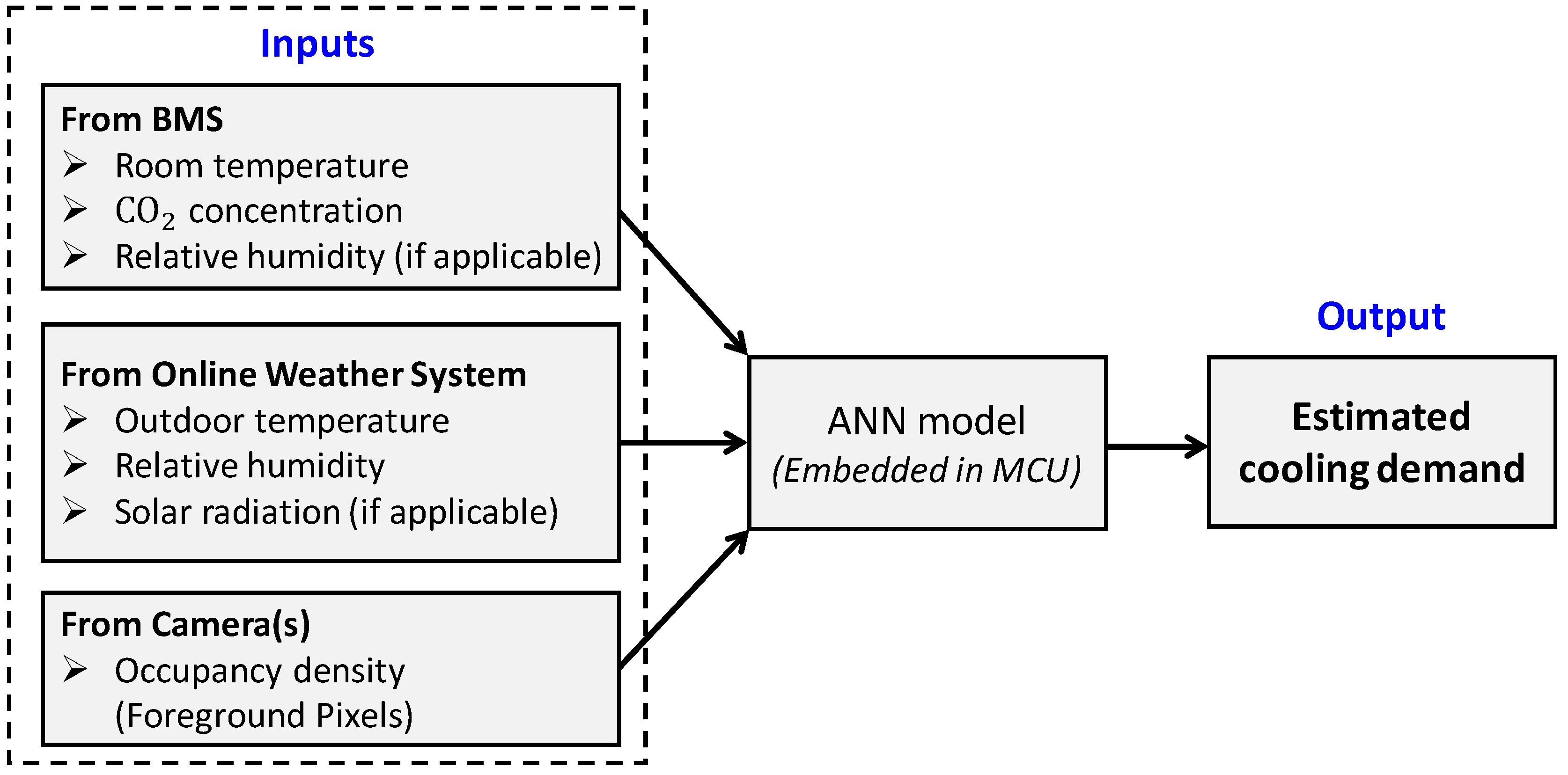
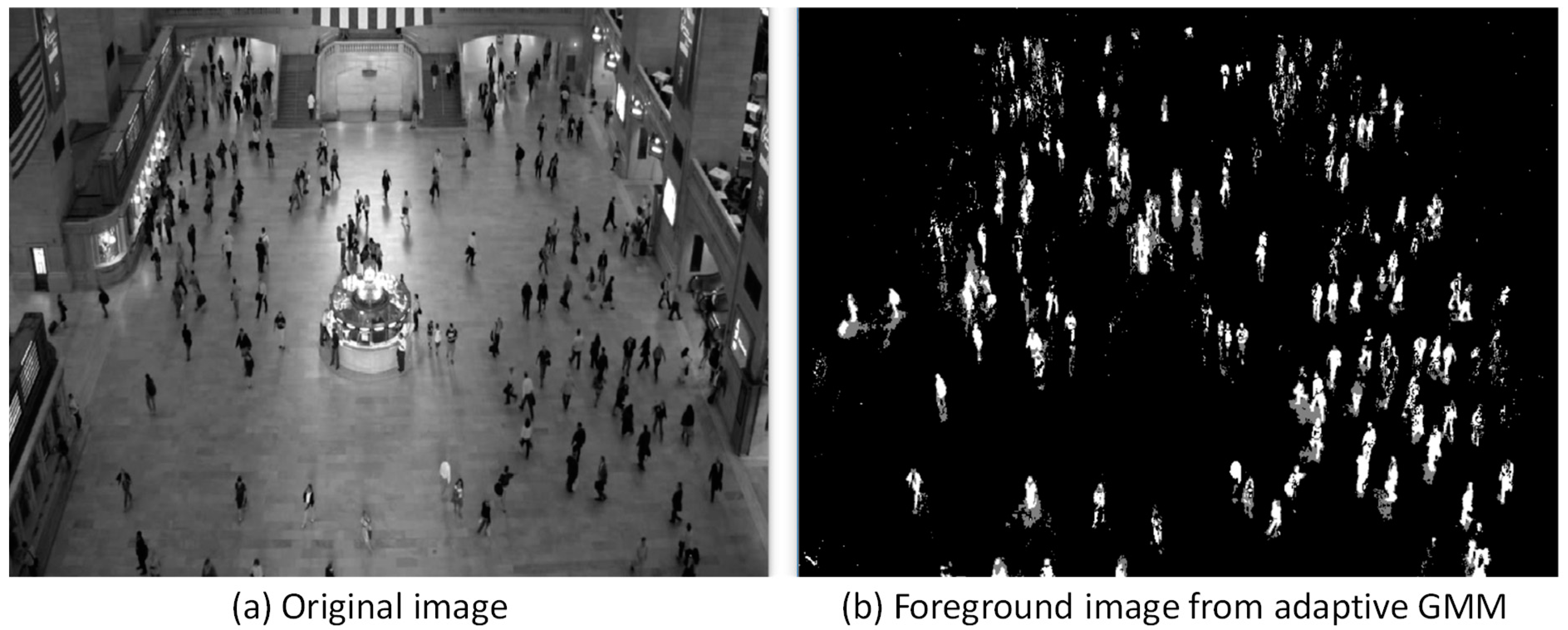
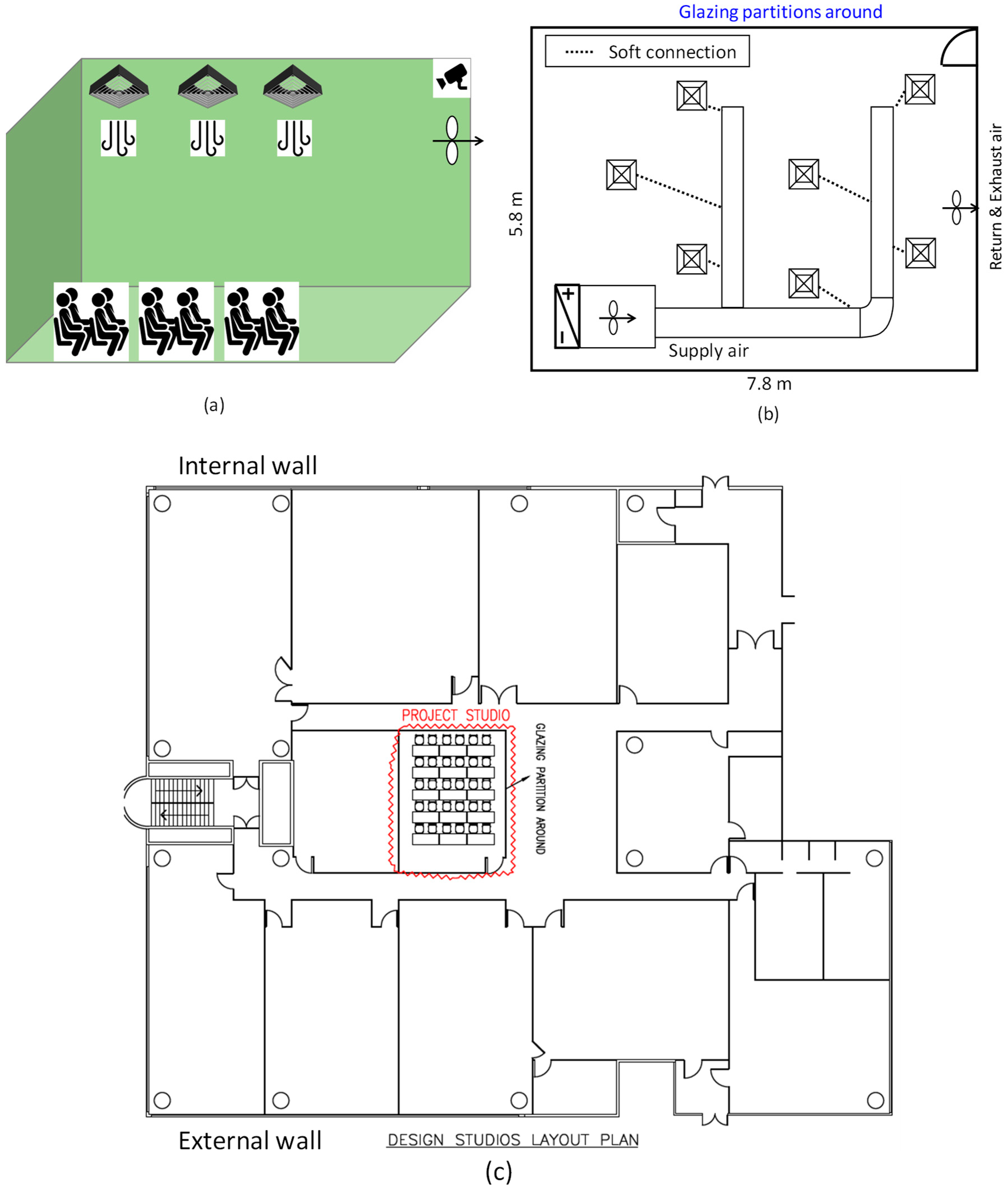
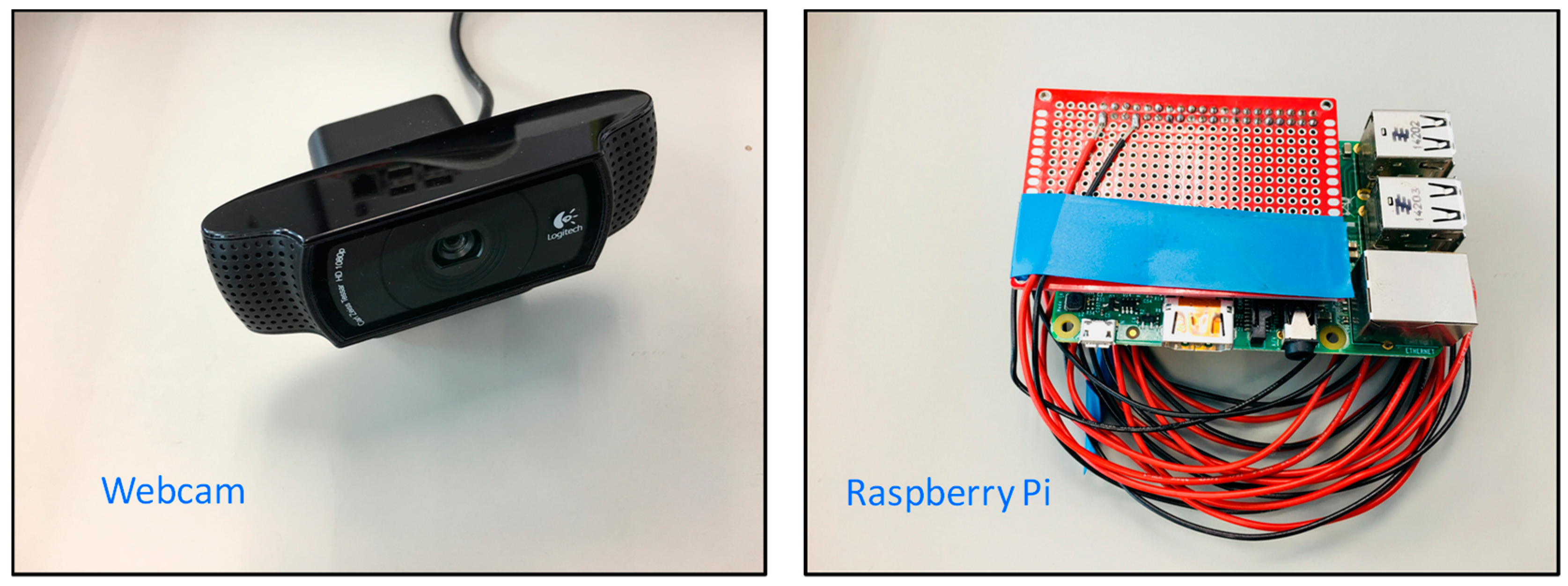
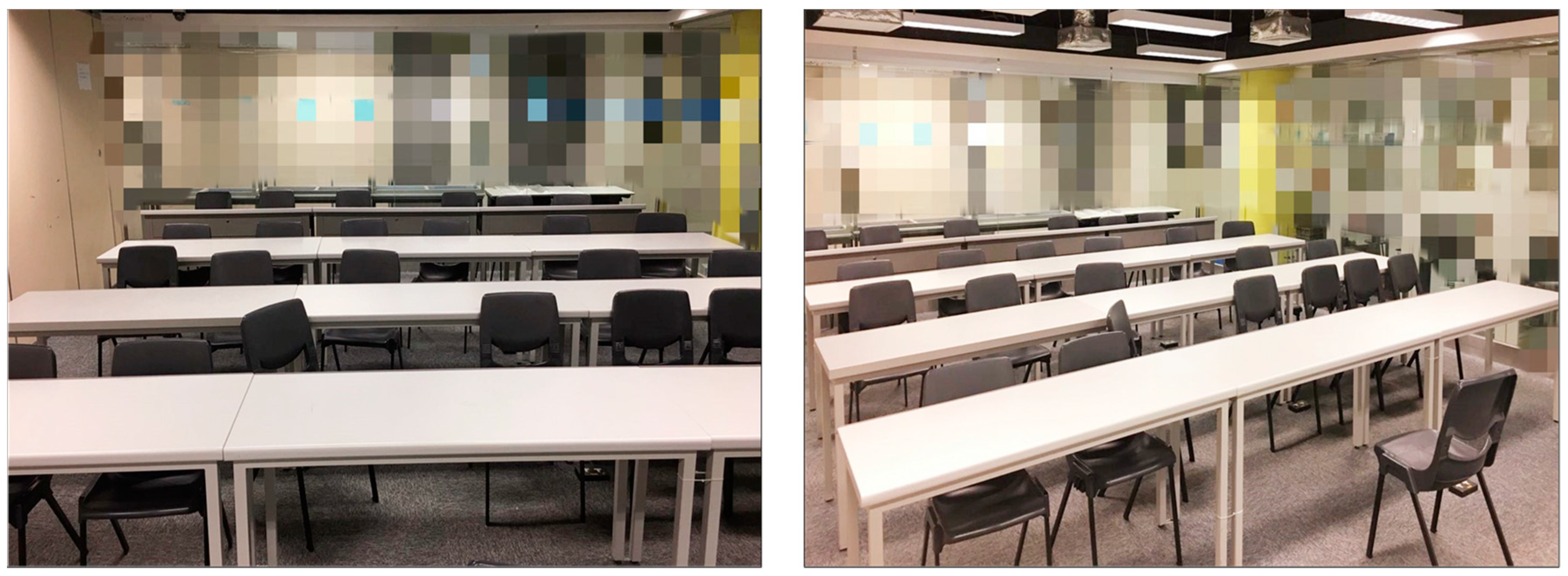

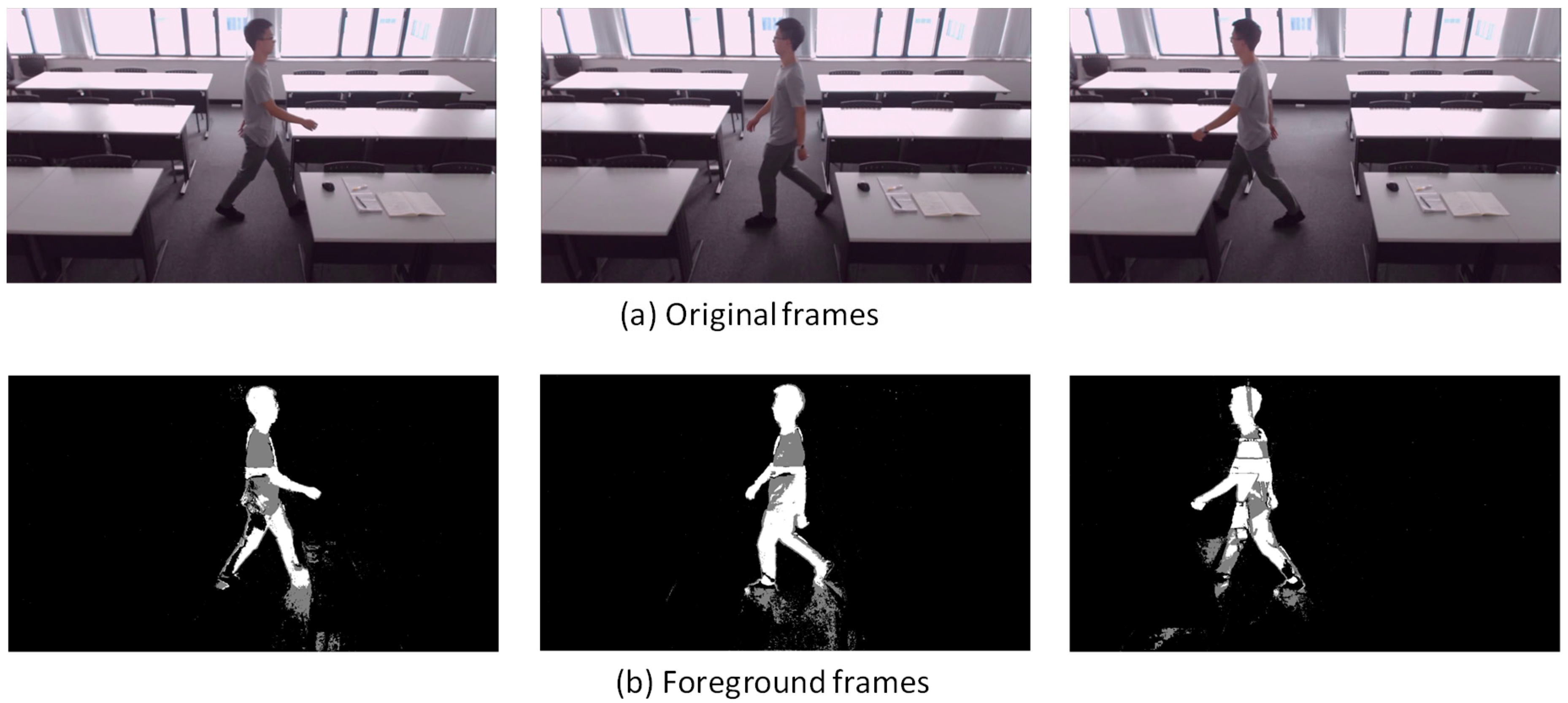
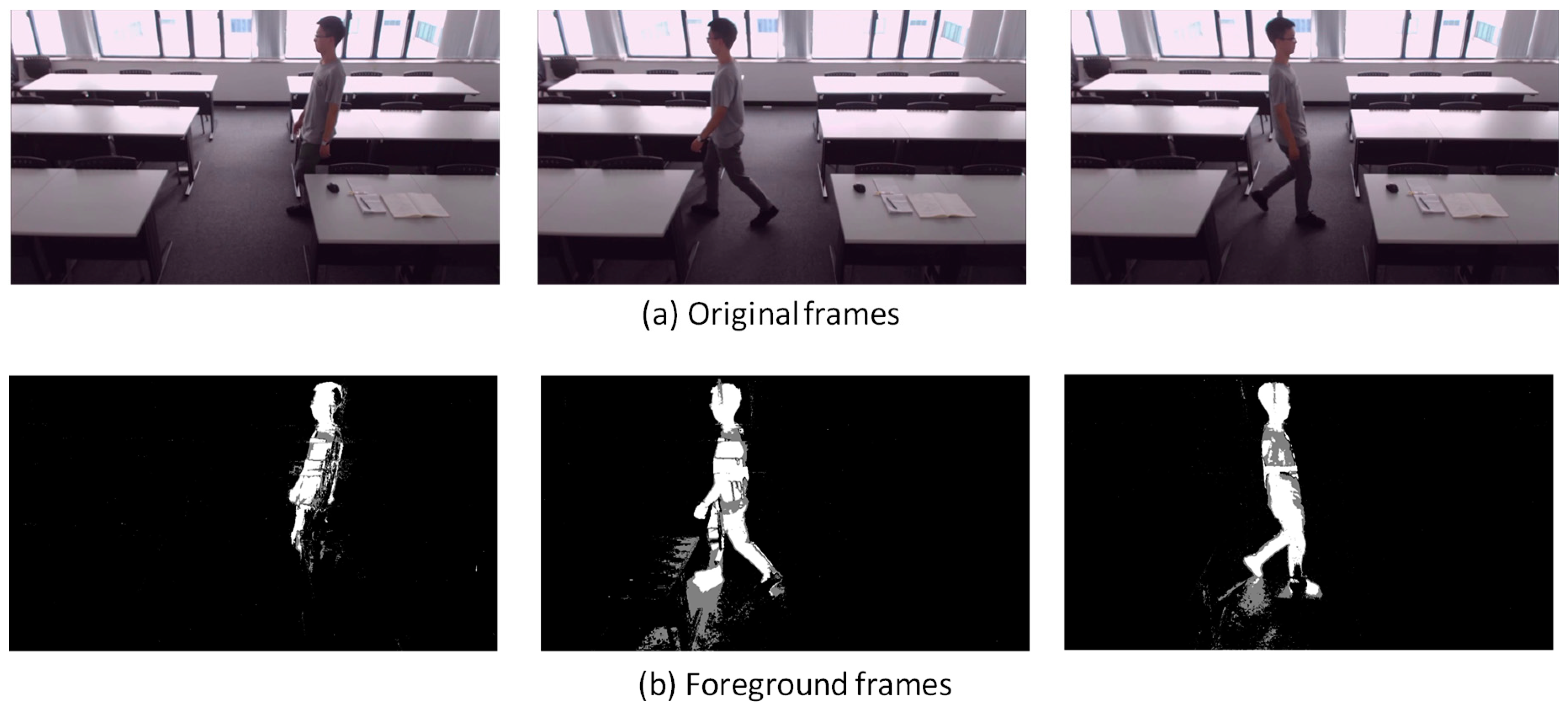
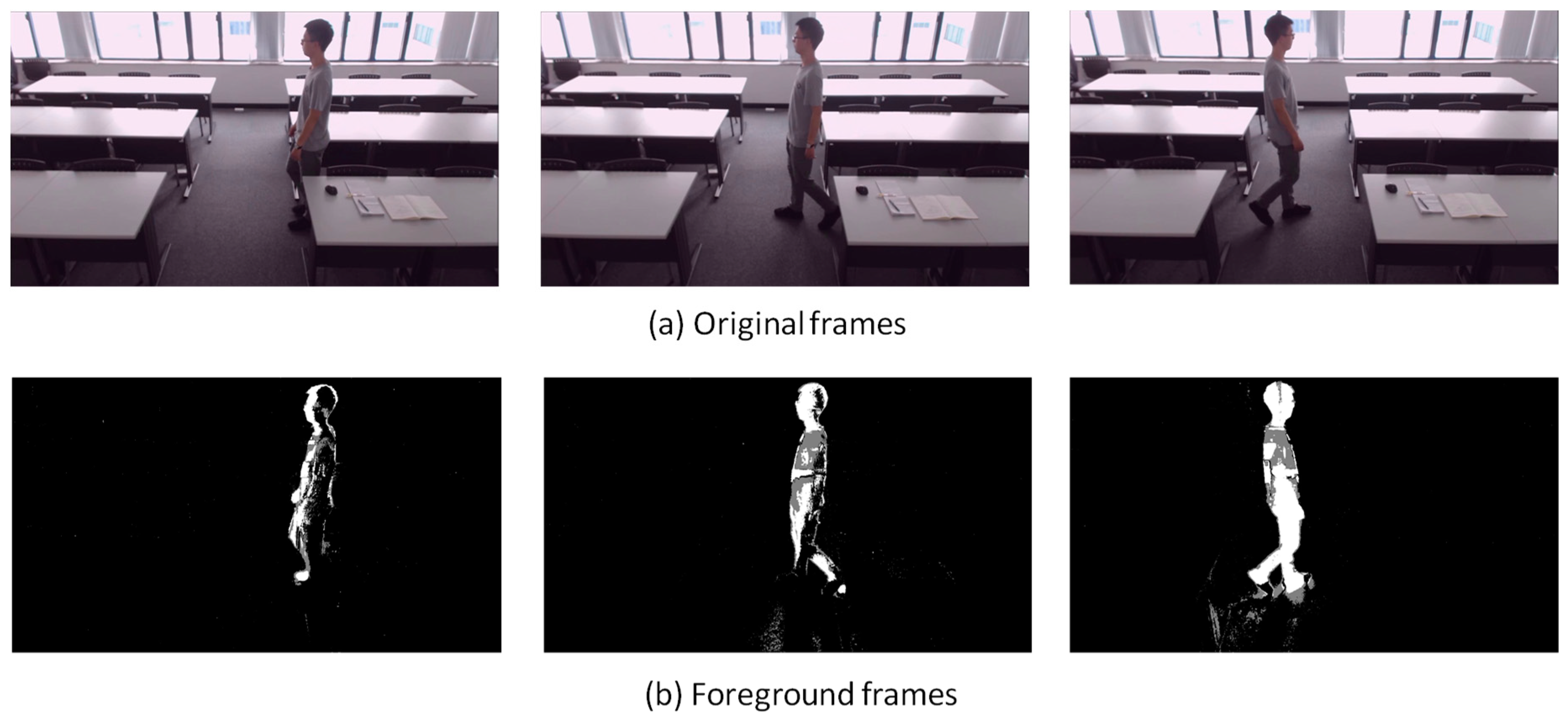

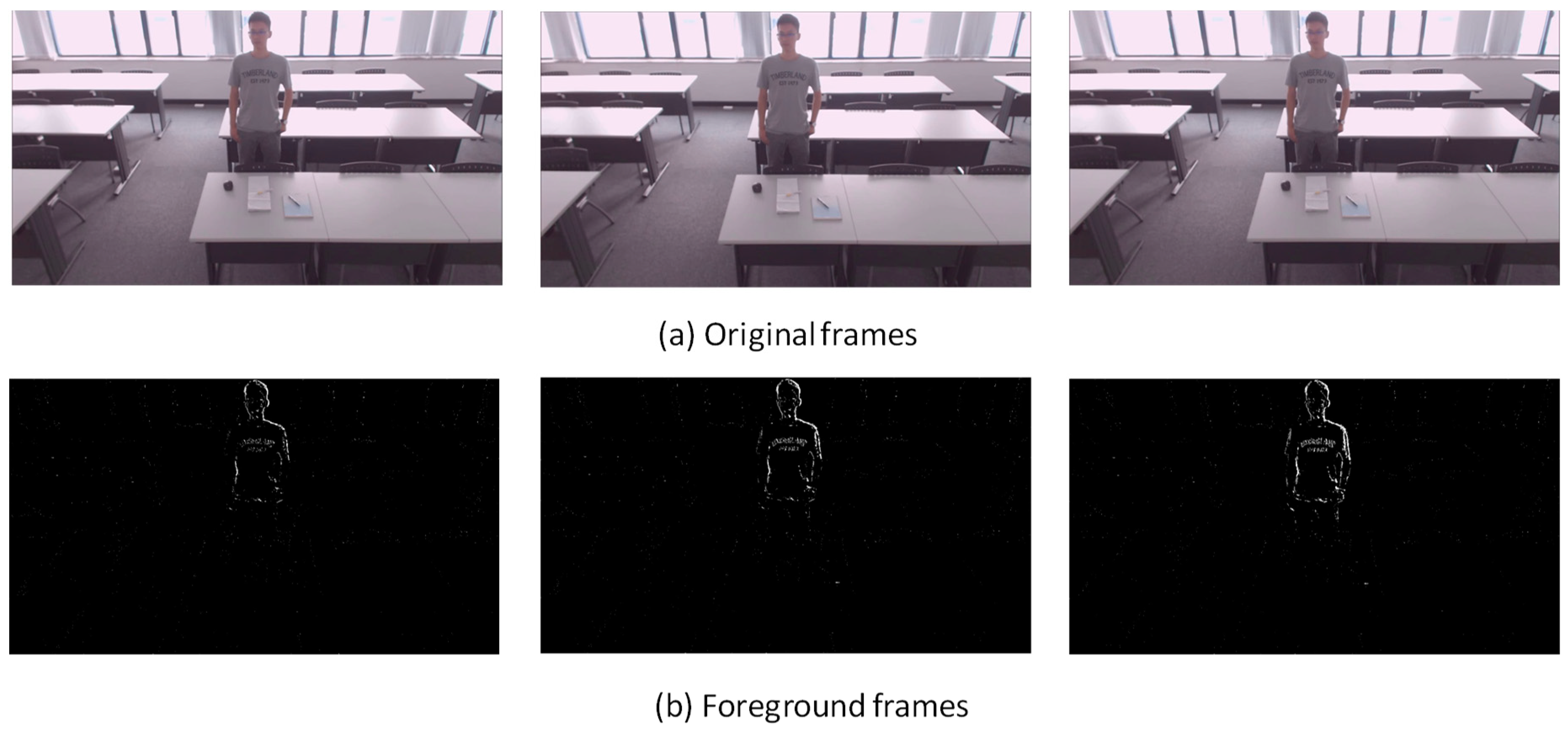

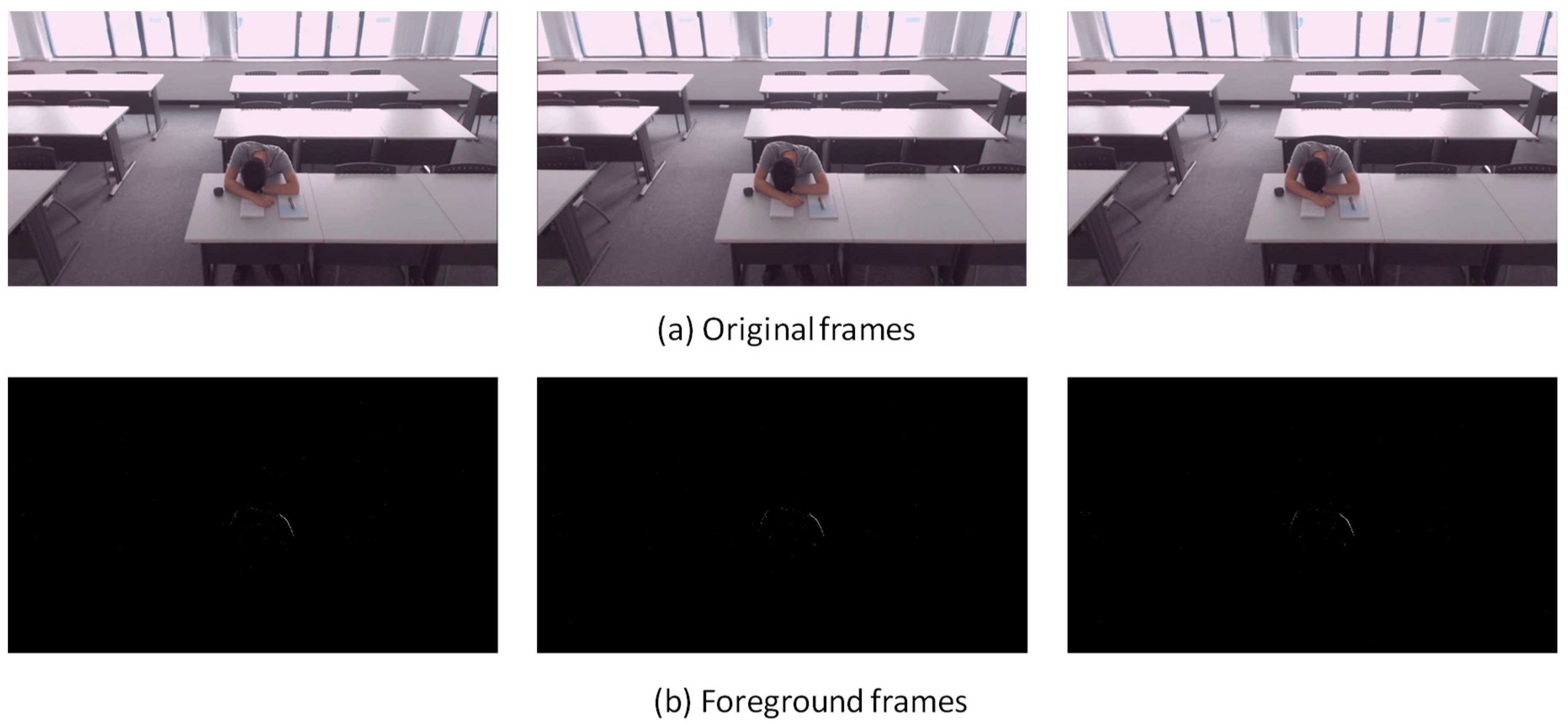

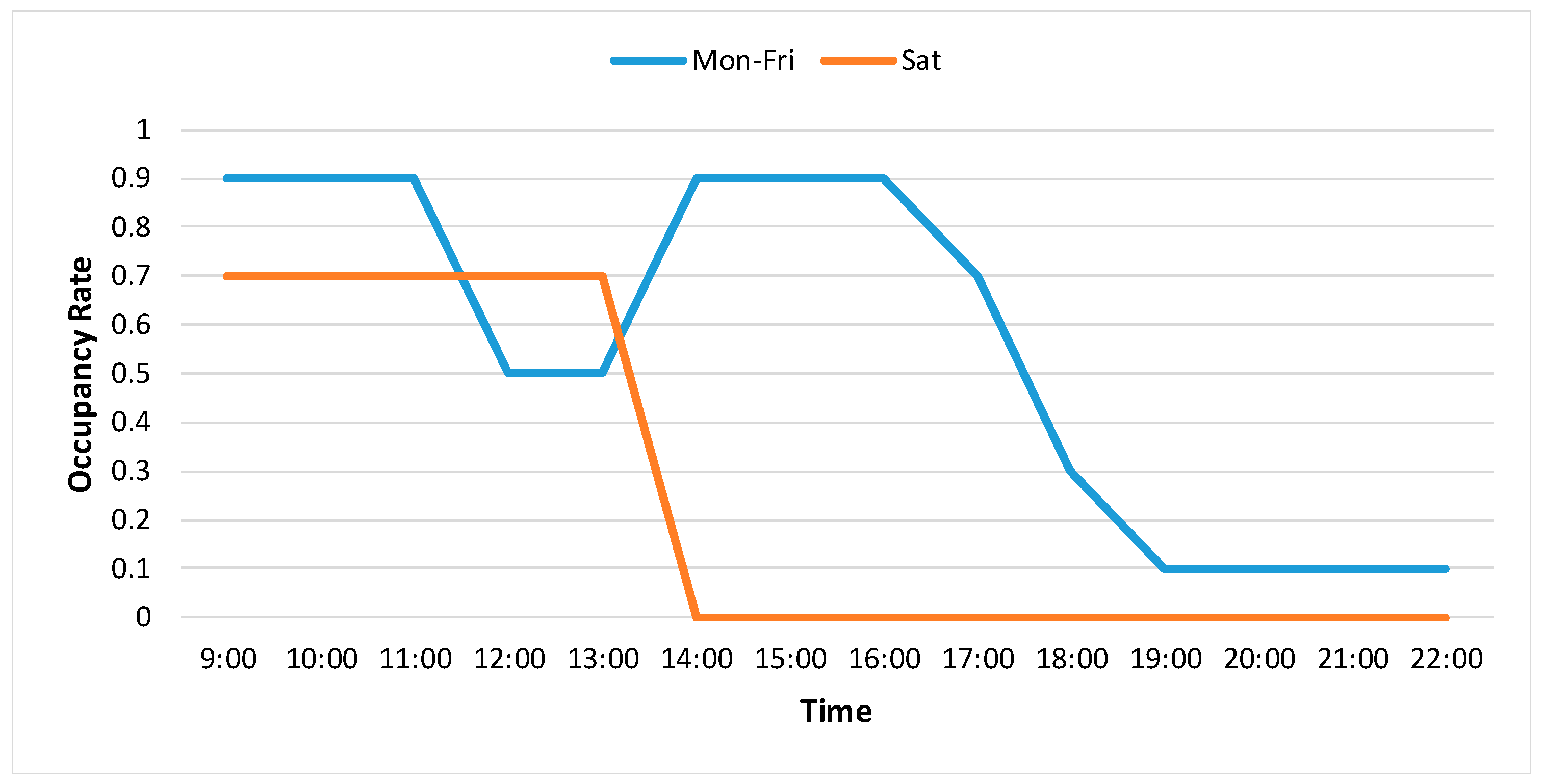
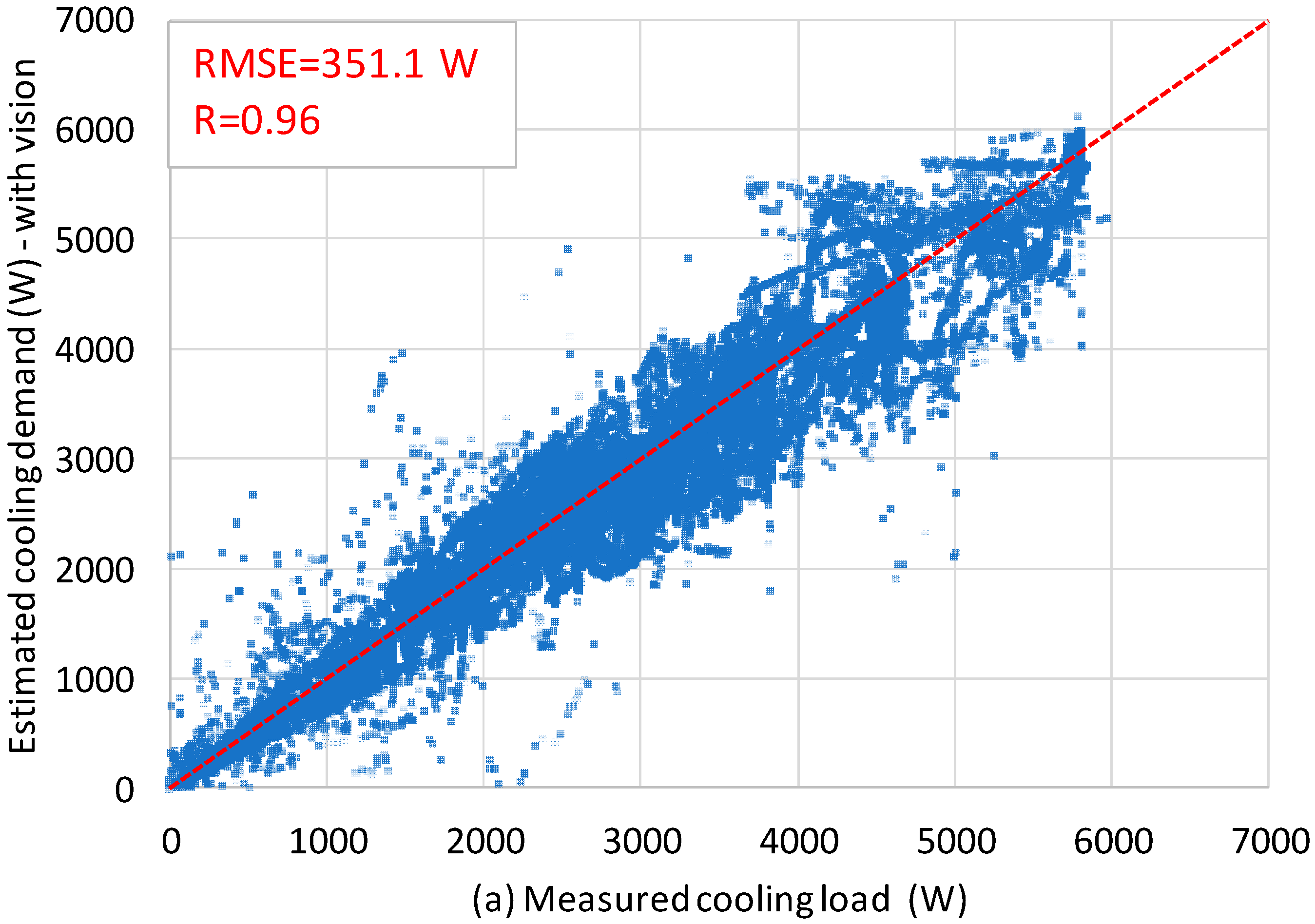
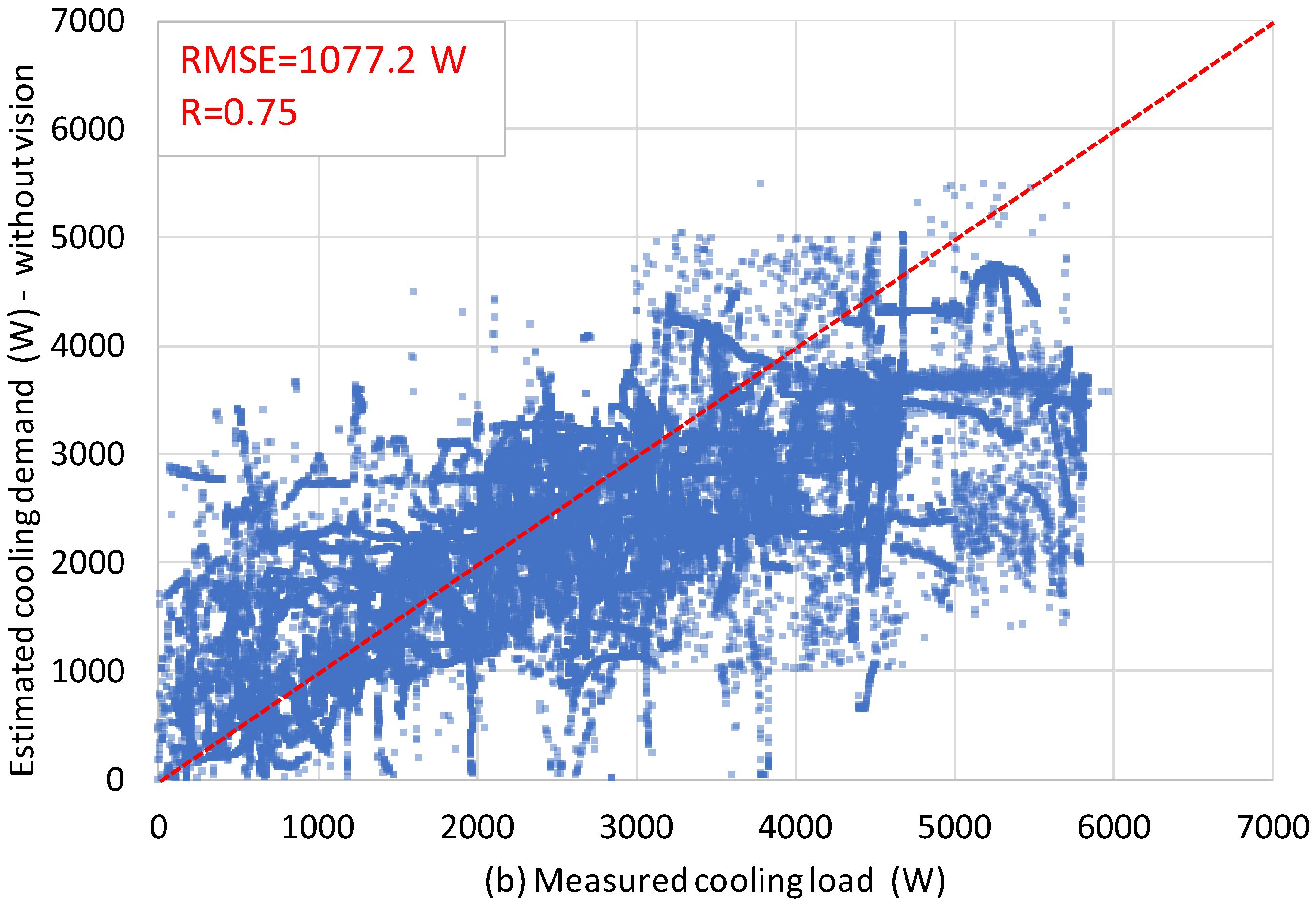
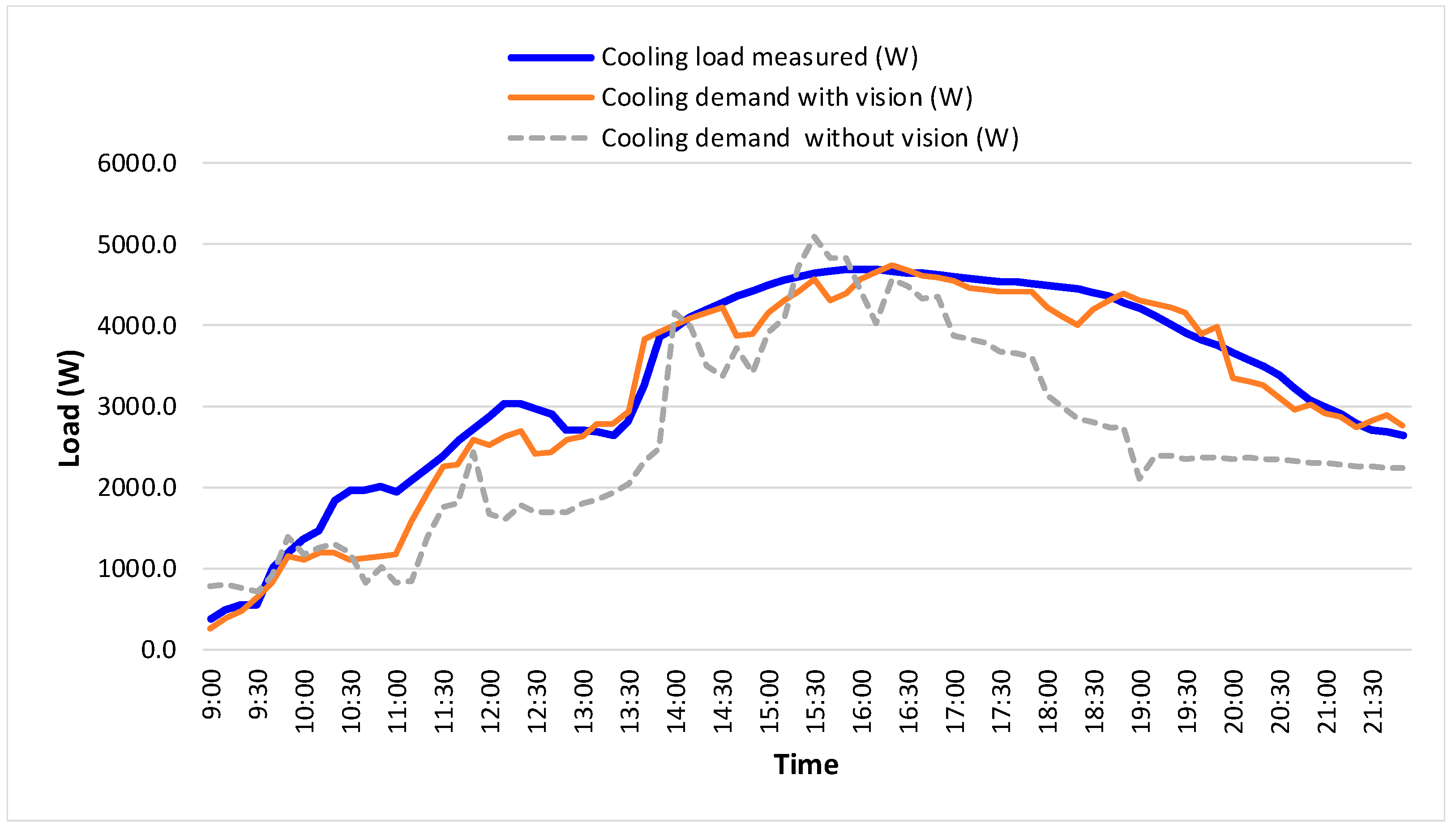
| Sensing Technology | Type of Sensing | Advantages | Disadvantages | Cost | Commonly Installed? (Yes/No) |
|---|---|---|---|---|---|
| temperature or relative humidity sensors | indirect |
|
| No | Yes |
| CO2 | indirect |
|
| No | Yes |
| Infrared | direct |
|
| Low (PIR); High (thermal cameras) | No |
| Wi-Fi or BLE | direct |
|
| No (Wi-Fi); Medium (BLE) | Yes (Wi-Fi); No (BLE) |
| RFID | direct |
|
| Medium | No |
| Sound | direct |
|
| Low | No |
| Vision-based detection | direct |
|
| No/Low (surveillance cameras); High (advanced cameras) | Yes (surveillance camera); No (advanced cameras) |
| Activity | Metabolic Rate—Male Adult () | Density of Foreground Moving Pixels |
|---|---|---|
| Sleeping | 40 | Very low |
| Standing, relaxed | 70 | Low |
| Office work (reading writing, typing) | 55–65 | Low |
| Walking (0.9 m/s) | 120 | Moderate |
| Walking (1.8 m/s) | 220 | High |
| Test room Area: 45 m2 | Maximum Number of Occupants: 30 Persons | ||||
|---|---|---|---|---|---|
| Equipment: One Projector and One PC | Lighting: Eight Luminaries | ||||
| Chiller Water Temperature | Measured Supply Water Temperature | 8.1–10.2 °C | Normal operation schedule | 07:00–23:00 (Weekdays) | |
| Measured Return Water Temperature | 14.5–17.5 °C | 07:00–18:00 (Saturdays) | |||
| Source | BMS | Online Weather System | Camera |
|---|---|---|---|
| Information | CO2 × 2, Return and supply air temperature | Temperature & Relative humidity | Real-time Streaming Video |
| No. of information | 4 | 2 | 1 |
| Connection Type | Internet | Internet | USB |
| Sensor accuracy | Temperature sensor: Sensirion STS30, ±0.2 °C at a temperature range of 0 °C to 65 °C; CO2 sensor: Telaire 7001, ±50 ppm or ±5% of reading up to 5000 PPM | N/A | N/A |
| Experimental Days | ||||
| Month | February | March | April | May |
| Date | 29 | 1–4, 7–10, 14–18, 28–31 | 18–22, 25–29 | 2 |
| Weather Statistics | ||||
| Maximum | Minimum | Mean | Standard Deviation | |
| Temperature (°C) | 30 | 10 | 21.24 | 4.34 |
| Humidity (%) | 100 | 25 | 79.39 | 13.99 |
| Activity Type | Metabolic Heat Generation Rate (w/m2) | DFMP (%) |
|---|---|---|
| walking—1.8 m/s | 220 | 3.12 |
| walking—1.2 m/s | 150 | 2.83 |
| walking—0.9 m/s | 115 | 2.47 |
| walking about | 100 | 1.83 |
| standing relaxed | 70 | 1.24 |
| reading & writing | 55 | 0.1 |
| sleeping | 40 | 0.028 |
© 2018 by the authors. Licensee MDPI, Basel, Switzerland. This article is an open access article distributed under the terms and conditions of the Creative Commons Attribution (CC BY) license (http://creativecommons.org/licenses/by/4.0/).
Share and Cite
Wang, J.; Tse, N.C.F.; Poon, T.Y.; Chan, J.Y.C. A Practical Multi-Sensor Cooling Demand Estimation Approach Based on Visual, Indoor and Outdoor Information Sensing. Sensors 2018, 18, 3591. https://doi.org/10.3390/s18113591
Wang J, Tse NCF, Poon TY, Chan JYC. A Practical Multi-Sensor Cooling Demand Estimation Approach Based on Visual, Indoor and Outdoor Information Sensing. Sensors. 2018; 18(11):3591. https://doi.org/10.3390/s18113591
Chicago/Turabian StyleWang, Junqi, Norman Chung Fai Tse, Tin Yan Poon, and John Yau Chung Chan. 2018. "A Practical Multi-Sensor Cooling Demand Estimation Approach Based on Visual, Indoor and Outdoor Information Sensing" Sensors 18, no. 11: 3591. https://doi.org/10.3390/s18113591
APA StyleWang, J., Tse, N. C. F., Poon, T. Y., & Chan, J. Y. C. (2018). A Practical Multi-Sensor Cooling Demand Estimation Approach Based on Visual, Indoor and Outdoor Information Sensing. Sensors, 18(11), 3591. https://doi.org/10.3390/s18113591






